The Tesoro Gram Spectrum Low Profile Mechanical Keyboard Review
by E. Fylladitakis on August 22, 2016 8:00 AM EST- Posted in
- Mechanical Keyboards
- Peripherals
- Keyboard
- Tesoro
- RGB
Software
Tesoro usually creates graphically fancy software packages, even if the user interface is simple and the options limited. This time Tesoro decided to go with a clean, simplistic design, but the software remains relatively unsophisticated for a keyboard of this class. It is however very easy to learn and use, with every option and setting cleanly arranged on a single screen.
At the top right side of the UI, the user can select between the “PC Mode” and any of the five programmable profiles. The PC Mode is the basic keyboard mode that disables all advanced functions and has the Gram Spectrum behaving like any ordinary keyboard. Each of the five profiles can be “Synced”, that is linked to a specific application, automatically engaging when the application starts.
The Tesoro Gram Spectrum is a fully programmable keyboard, allowing the user to freely disable or reprogram any of its keys. It is possible to either re-map a key, to launch applications with it or to perform a macro that has been programmed using the software. The macro recorder however is rather basic. Macro recording is initiated by clicking the "Start Record" button, all key presses with their time delays will be recorded, and then it will stop once the "Stop Record" button is clicked. The time delays and the sequence can be edited, as well as new key presses can be inserted into an existing macro. It is also possible to set the macro to repeat a finite number of times, as long as the key is being held pressed or until it is pressed again. However, the recorder is unable to record anything beyond keyboard keystrokes, such as mouse movements and clicks.
The illumination button brings out a menu of nine basic colors, plus a palette with any possible RGB color. The palette is very small and seems difficult to select an exact color, but the software also allows manual input of the RGB code of the color, allowing for precise fine tuning. Special effects can also be selected for the entire keyboard, such as a rainbow wave and “breathing” brightness effects.
Per-Key Quality Testing
In order to test the quality and consistency of a keyboard, we are using a texture analyser that is programmed to measure and display the actuation force of the standard keyboard keys. By measuring the actuation force of every key, the quality and consistency of the keyboard can be quantified. It can also reveal design issues, such as the larger keys being far softer to press than the main keys of the keyboard. The actuation force is measured in Centinewton (cN). Some companies use another figure, gram-force (gf). The conversion formula is 1 cN = 1.02 gf (i.e. they are about the same). A high quality keyboard should be as consistent as possible, with an average actuation force as near to the manufacturer's specs as possible and a disparity of less than ±10%. Greater differences are likely to be perceptible by users. It is worth noting that there is typically variance among keyboards, although most keyboard companies will try and maintain consistency - as with other reviews, we're testing our sample only.
The machine we use for our testing is accurate enough to provide readings with a resolution of 0.1 cN. For wider keys (e.g. Enter, Space Bar, etc.), the measurement is taking place at the center of the key, right above the switch. Note that large keys generally have a lower actuation force even if the actuation point is at the dead center of the key. This is natural, as the size and weight of the keycap reduces the required actuation force. For this reason, we do display the force required to actuate every key but we only use the results of the typical sized keys for our consistency calculations. Still, very low figures on medium sized keys, such as the Shift and Enter keys reveal design issues and can easily be perceptible by the user.
We were curious to see how the new, shortened “Agile” switches would perform and their quality proved to be satisfactory. The switches are significantly heavier than their normal Blue counterparts, though we should note that Tesoro does not claim that these switches should share the performance of the typical Blue switch. As the spring of the switches appears to be of the same size and type as that we found in Blue switches, the shortened stem probably “pre-loads” the spring, stiffening the remainder of its travel. We measured an average actuation force of 52.3 cN with a disparity of ±8.54% across the main keys, a relatively high but reasonable figure.


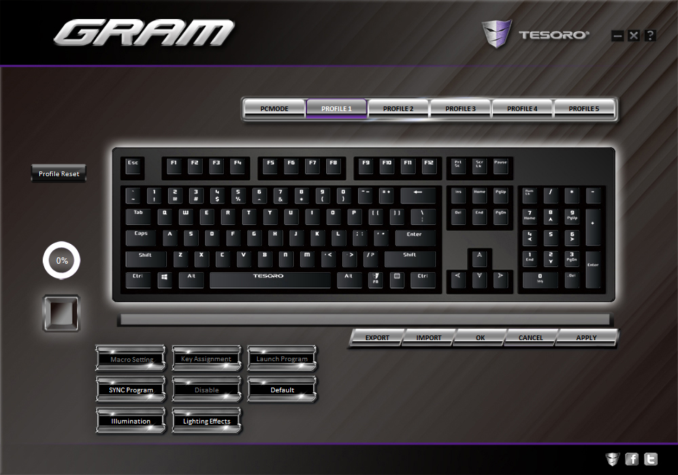
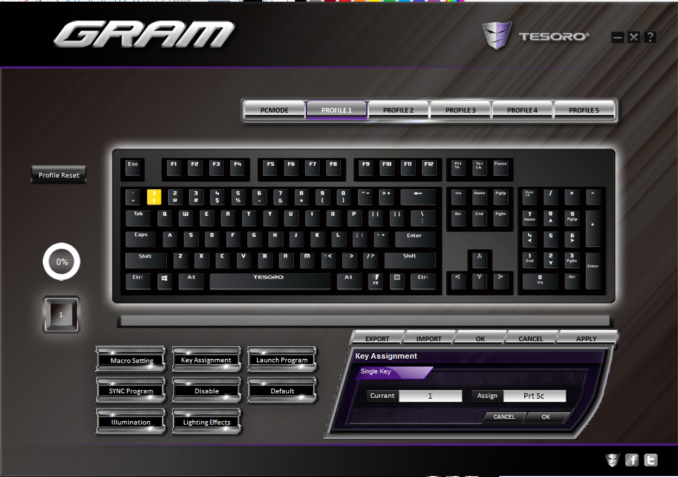

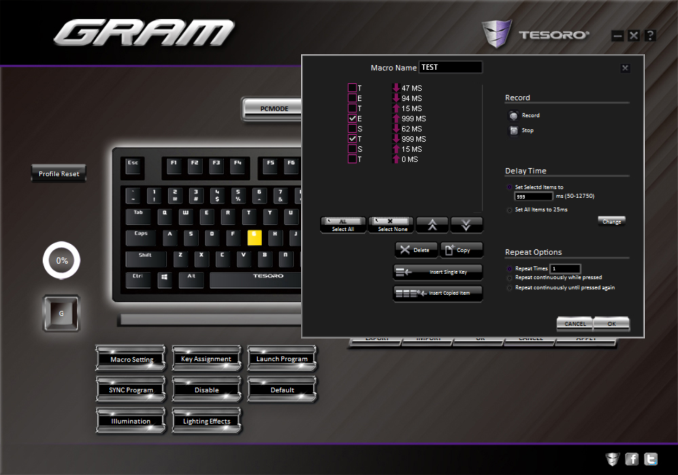
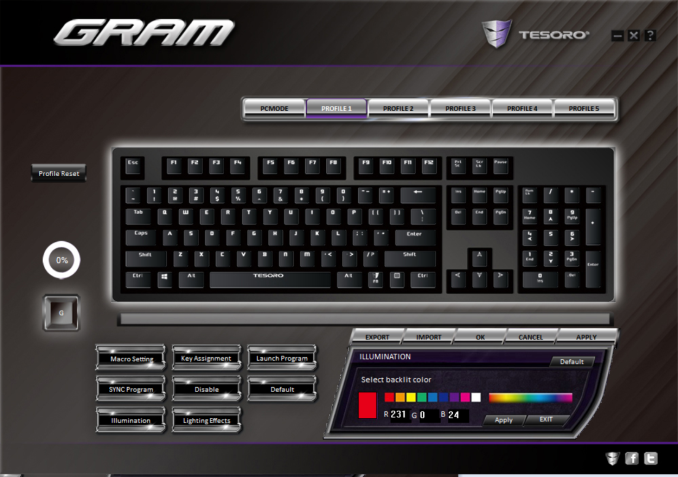
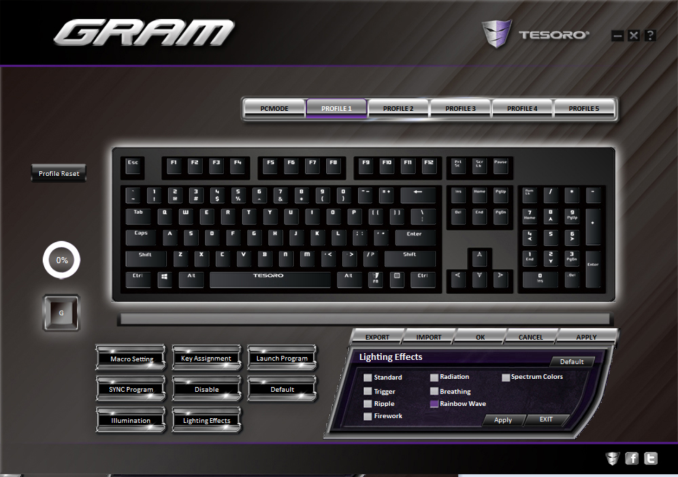









27 Comments
View All Comments
Stochastic - Monday, August 22, 2016 - link
Hi all. I'm considering splurging on a mechanical keyboard. Can anyone recommend the best available models that are sub-$100? I will use it for both gaming and productivity work and my preference would be for Cherry Brown switches or something similar.Stochastic - Monday, August 22, 2016 - link
My top considerations at the moment are the Corsair Strafe and the Rosewill Mechanical Keyboard. Have any of you used these keyboards? Thanks.JoeyJoJo123 - Monday, August 22, 2016 - link
I really dislike Corsair mechanical keyboards due to their nonstandard key layout on the bottom row, where they make the Ctrl and Alt keys larger, and the Windows and Command/Function keys smaller. I do like purchasing novelty keycap sets to replace the default keycaps after some time to get new look, and often enough the stock keycaps included are made with incredibly brittle keycaps that just break after time.These are your options on the market right now:
https://pcpartpicker.com/products/keyboard/#k=1&am...
I do prefer the Logitech G610, personally.
It has a standard keycap layout, authentic Cherry MX Brown switches, moves extra functionality to its own dedicated keys (rather than a function key + another key shenanigans that many keyboards like to do), inoffensive logos/branding (just that simple Logitech G logo for their gaming products at the top left), keyboard macros (if you're into that) by remapping seldomly used F-keys during games, a high key rollover via USB, etc.
My second choice would be the Rosewill RK-9000V2 BR, again due to the simpler look, but it's also the cheapest option that does use authentic Cherry MX Brown switches. It also doesn't have that bulky multi-cable thing that the Rosewill Apollo has, which introduces an awfully positioned USB, mic, and headphone hub at the cost of a much thicker cable that plugs into multiple ports on the PC.
wolrah - Tuesday, August 23, 2016 - link
"I really dislike Corsair mechanical keyboards due to their nonstandard key layout on the bottom row, where they make the Ctrl and Alt keys larger, and the Windows and Command/Function keys smaller."I'll agree that it's not the ANSI standard layout, but since Razer and CM Storm also use the same layout (CM Storm only on some products) one could argue that it's a de facto standard. De facto standards of course depend on adoption, but Corsair and Razer are pretty much 2/3 of the reason mechanical keyboards are available at mainstream retailers.
That said of course I am disappointed as a K95 RGB owner that most keysets are unavailable to me, but then again from what I've seen most are anyways because I like my backlighting and want to keep it useful. Replacement keysets with properly backlight-compatible translucent legends on opaque (or at least much darker) keys are all but nonexistent. The majority of "backlight compatible" sets are fully translucent or even transparent keys. This can look good in some cases but it a lot less useful at providing a readable legend in a darkened environment.
tl;dr: It's sort of a standard, but it does suck that it limits aftermarket options, but the aftermarket really doesn't cater to backlit keyboards anyways so meh.
JoeyJoJo123 - Tuesday, August 23, 2016 - link
1) It's not a defacto standard. ANSI is a standard. ISO is a standard. Corsair's layout is a more "gamer-friendly" standard that shrinks windows keys to make it less likely for users to press the Windows key during games (which often minimizes the game and brings up the Windows home menu), and makes the Ctrl and Alt keys bigger, which are common keys that are bound to actions in-game. However, by doing this (instead of opting for a a switch on the board that can toggle whether to register Windows key presses or not), the keyboard is automatically not compatible with the vast majority of ANSI compatible Cherry MX stem keyboards. (Note, there are other ANSI keyboards that don't use Cherry MX switches, but have Cherry MX stems for use with standard ANSI layout Cherry MX stem keycap sets, such as the CoolerMaster Nova Touch).2) Backlit compatible keycap sets do exist, but are indeed rarer than non backlit compatible keycap sets. However, backlit compatible keycap sets regularly are available on Massdrop every few weeks, and there's actually a drop right now for such a set: https://www.massdrop.com/buy/backlit-doubleshot-pb... That being said, from an ergonomics standpoint, I do vastly prefer to have an overhead lamp lighting my work area at night. Additionally, I've learned to touch type years ago and I actually prefer to have keycap sets without legends. I've found that legends add another layer of potential failure for keycaps, as pad printing wears off, doubleshot keycaps are (uncommonly) brittle when they use a brittle plastic for the legend, etc. Solid color keycaps never change except for the texture over time, which will smoothen out over time.
You won't actually learn to fully touch-type until you give up legends or to stop ever looking at the keyboard.
tarqsharq - Tuesday, August 23, 2016 - link
I have a Rosewill one with brown keys. Build quality was fine except the connector wasn't held down by much more than solder so that's a potential weak point.I bought that 3 years ago, so not sure if they changed it up since then.
Stochastic - Monday, August 22, 2016 - link
Ooops...I should have checked Google first. Anandtech already has reviews of these. Mr. Fylladitakis, may I ask which are your favorite keyboards at the moment?E.Fyll - Monday, August 22, 2016 - link
You may ask, but my answer would not be helpful to you. The keyboard is a device that needs to meet someone's specific needs and my personal needs are unlikely to be the same as yours. Aesthetics aside, you need to ascertain whether you want a) lighting, b) per-key programmability and c) extra macro keys, volume control knobs, etc.That being said, the Corsair K70 Rapidfire is for sale in Amazon for $110 right now and I would find it difficult to recommend something else for that price. If $100 is strictly your budget, then I would probably suggest the $90 Cougar 600K, it is a very solid model for the money and comes with a fairly good software package. However, if you do not need either lighting or programmable keys, you would most likely be happy with a $60 Nixeus Moda Pro, but the white color just isn't for everyone, or even a 10keyless CM Quickfire Rapid.
nathanddrews - Monday, August 22, 2016 - link
I got the Thermaltake Meka G1 a few years ago and I still love it. Cherry MX Black keys with red LED backlighting. It was $89 on sale when I got it, but I don't know if they still make it.https://amzn.com/B00CYAQKGM
NeonFlak - Monday, August 22, 2016 - link
I've got around 17 different mechanical keyboards. This is the one I find myself always going back too and I couldn't tell you why.https://www.amazon.com/Coolermaster-SGK-4000-GKCL1...